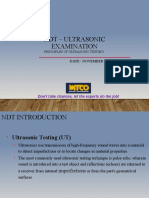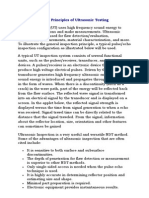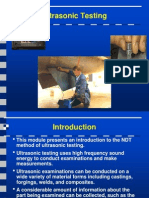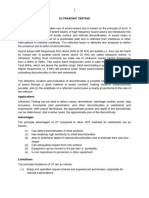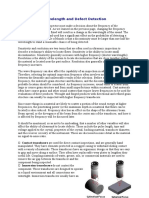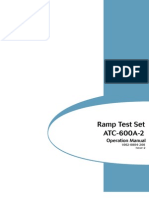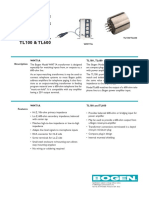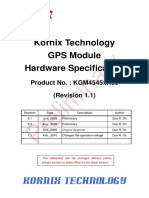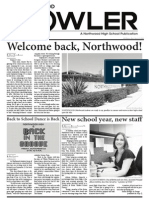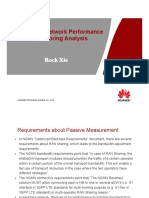Ultrasonic Testing: Department of Mechanical Engineering, SJCIT
Ultrasonic Testing: Department of Mechanical Engineering, SJCIT
Uploaded by
gabrielCopyright:
Available Formats
Ultrasonic Testing: Department of Mechanical Engineering, SJCIT
Ultrasonic Testing: Department of Mechanical Engineering, SJCIT
Uploaded by
gabrielOriginal Description:
Original Title
Copyright
Available Formats
Share this document
Did you find this document useful?
Is this content inappropriate?
Copyright:
Available Formats
Ultrasonic Testing: Department of Mechanical Engineering, SJCIT
Ultrasonic Testing: Department of Mechanical Engineering, SJCIT
Uploaded by
gabrielCopyright:
Available Formats
Ultrasonic Testing
CONTENTS
Introduction
Basic principle of working
Advantages and disadvantages
Physics of ultrasound
Equipment and Transducers
Calibration methods
References
Conclusion
Department Of Mechanical Engineering,SJCIT Page 1
Ultrasonic Testing
INTRODUCTION
Ultrasonic Testing (UT) uses high frequency sound waves (typically in the range between 0.5
and 15 MHz) to conduct examinations and make measurements. Besides its wide use in
engineering applications (such as flaw detection/evaluation, dimensional measurements,
material characterization, etc.), ultrasonics are also used in the medical field (such as
sonography, therapeutic ultrasound, etc.).
In general, ultrasonic testing is based on the capture and quantification of either the reflected
waves (pulse-echo) or the transmitted waves (through-transmission). Each of the two types is
used in certain applications, but generally, pulse echo systems are more useful since they
require one-sided access to the object being inspected.
Department Of Mechanical Engineering,SJCIT Page 2
Ultrasonic Testing
BASIC PRINCIPLES
A typical pulse-echo UT inspection system consists of several functional units, such as the
pulser/receiver, transducer, and a display device. A pulser/receiver is an electronic device that
can produce high voltage electrical pulses. Driven by the pulser, the transducer generates
high frequency ultrasonic energy. The sound energy is introduced and propagates through the
materials in the form of waves. When there is a discontinuity (such as a crack) in the wave
path, part of the energy will be reflected back from the flaw surface. The reflected wave
signal is transformed into an electrical signal by the transducer and is displayed on a screen.
Knowing the velocity of the waves, travel time can be directly related to the distance that the
signal traveled. From the signal, information about the reflector location, size, orientation and
other features can sometimes be gained.
Department Of Mechanical Engineering,SJCIT Page 3
Ultrasonic Testing
ADVANTAGES AND DISADVANTAGES
The primary advantages and disadvantages when compared to other NDT methods are:
ADVANTAGES
It is sensitive to both surface and subsurface discontinuities.
The depth of penetration for flaw detection or measurement is superior to other NDT
methods.
Only single-sided access is needed when the pulse-echo technique is used.
It is highly accurate in determining reflector position and estimating size and shape.
Minimal part preparation is required.
It provides instantaneous results.
Detailed images can be produced with automated systems.
It is nonhazardous to operators or nearby personnel and does not affect the material
being tested.
It has other uses, such as thickness measurement, in addition to flaw detection.
Its equipment can be highly portable or highly automated.
DISADVANTAGES
Surface must be accessible to transmit ultrasound.
Skill and training is more extensive than with some other methods.
It normally requires a coupling medium to promote the transfer of sound energy into
the test specimen.
Materials that are rough, irregular in shape, very small, exceptionally thin or not
homogeneous are difficult to inspect.
Cast iron and other coarse grained materials are difficult to inspect due to low sound
transmission and high signal noise.
Linear defects oriented parallel to the sound beam may go undetected.
Reference standards are required for both equipment calibration and the
characterization of flaws.
Department Of Mechanical Engineering,SJCIT Page 4
Ultrasonic Testing
PHYSICS OF ULTRASOUND
WAVE PROPAGATION
Ultrasonic testing is based on the vibration in materials which is generally referred to as
acoustics. All material substances are comprised of atoms, which may be forced into
vibrational motion about their equilibrium positions. Many different patterns of vibrational
motion exist at the atomic level; however, most are irrelevant to acoustics and ultrasonic
testing. Acoustics is focused on particles that contain many atoms that move in harmony to
produce a mechanical wave. When a material is not stressed in tension or compression
beyond its elastic limit, its individual particles perform elastic oscillations. When the particles
of a medium are displaced from their equilibrium positions, internal restoration forces arise.
These elastic restoring forces between particles, combined with inertia of the particles, lead to
the oscillatory motions of the medium.
In solids, sound waves can propagate in four principal modes that are based on the way the
particles oscillate. Sound can propagate as longitudinal waves, shear waves, surface waves,
and in thin materials as plate waves. Longitudinal and shear waves are the two modes of
propagation most widely used in ultrasonic testing. The particle movement responsible for
the propagation of longitudinal and shear waves is illustrated in the figure.
Department Of Mechanical Engineering,SJCIT Page 5
Ultrasonic Testing
In longitudinal waves, the oscillations occur in the longitudinal ldirection or the direction
of wave propagation. Since compression and expansion forces are active in these waves,
they are also called pressure or compression waves. They are also sometimes called density
waves because material density fluctuates as the wave moves. Compression waves can be
generated in gases, liquids, as well as solids because the energy travels through the atomic
structure by a series of compressions and expansion movements.
In the transverse or shear waves, particles oscillate at a right angle or transverse to the
direction of propagation. Shear waves require an acoustically solid material for effective
propagation, and therefore, are not effectively propagated in materials such as liquids or
gasses. Shear waves are relatively weak when compared to longitudinal waves. In fact, shear
waves are usually generated in materials using some of the energy from longitudinal waves.
Department Of Mechanical Engineering,SJCIT Page 6
Ultrasonic Testing
Modes of Sound Wave Propagation
In air, sound travels by the compression and rarefaction o f air molecules in the direction of
travel. However, in solids, molecules can support vibrations in other directions. Hence, a
number of different types of sound waves are possible. Waves can be characterized by
oscillatory patterns that are capable of maintaining their shape and propagating in a stable
manner. The propagation of waves is often described in terms of what are called “wave
modes”.
As mentioned previously, longitudinal and transverse (shear) waves are most often used in
ultrasonic inspection. However, at surfaces and interfaces, various types of elliptical or
complex vibrations of the particles make other waves possible. Some of these wave modes
such as Rayleigh and Lamb waves are also useful for ultrasonic inspection.
Though there are many different modes of wave propagation, the table summarizes the four
types of waves that are commonly used in NDT.
Wave Type Particle Vibration
Longitudinal (Compression) Parallel to wave direction
Transverse (Shear) Perpendicular to wave direction
Surface - Rayleigh Elliptical orbit - symmetrical mode
Plate Wave - Lamb Component perpendicular to surface
Since longitudinal and transverse waves were discussed previously, surface and plate waves
are introduced here.
WAVELENGTH AND DEFECT DETECTION
In ultrasonic testing, the inspector must make a decision about the frequency of the
transducer that will be used in order to control the wavelength. The wavelength of the
ultrasound used has a significant effect on the probability of detecting a discontinuity. A
general rule of thumb is that a discontinuity must be larger than one-half the wavelength to
stand a reasonable chance of being detected.
Sensitivity and resolution are two terms that are often used in ultrasonic inspection to
describe a technique's ability to locate flaws. Sensitivity is the ability to locate small
discontinuities. Sensitivity generally increases with higher frequency (shorter wavelengths).
Resolution is the ability of the system to locate discontinuities that are close together within
Department Of Mechanical Engineering,SJCIT Page 7
Ultrasonic Testing
the material or located near the part surface. Resolution also generally increases as the
frequency increases.
The wave frequency can also affect the capability of an inspection in adverse ways.
Therefore, selecting the optimal inspection frequency often involves maintaining a balance
between the favorable and unfavorable results of the selection. Before selecting an inspection
frequency, the material's grain structure and thickness, and the discontinuity's type, size, and
probable location should be considered. As frequency. increases, sound tends to scatter from
large or course grain structure and from small imperfections within a material. Cast materials
often have coarse grains and thus require lower frequencies to be used for evaluations of
these products. Wrought and forged products with directional and refined grain structure can
usually be inspected with higher frequency transducers.
Since more things in a material are likely to scatter a portion of the sound energy at higher
frequencies, the penetration depth (the maximum depth in a material that flaws can be
located) is also reduced. Frequency also has an effect on the shape of the ultrasonic beam.
Beam spread, or the divergence of the beam from the center axis of the transducer, and how it
is affected by frequency will be discussed later.
It should be mentioned, so as not to be misleading, that a number of other variables will also
affect the ability of ultrasound to locate defects. These include the pulse length, type and
voltage applied to the crystal, properties of the crystal, backing material, transducer diameter,
and the receiver circuitry of the instrument. These are discussed in more detail in a later
section.
Department Of Mechanical Engineering,SJCIT Page 8
Ultrasonic Testing
EQUIPMENT & TRANSDUCERS
PIEZOELECTRIC TRANSDUCERS
The conversion of electrical pulses to mechanical vibrations and the conversion of returned
mechanical vibrations back into electrical energy is the basis for ultrasonic testing. This
conversion is done by the transducer using a piece of piezoelectric material (a polarized
material having some parts of the molecule positively charged, while other parts of the
molecule are negatively charged) with electrodes attached to two of its opposite faces. When
an electric field is applied across the material, the polarized molecules will align themselves
with the electric field causing the material to change dimensions. In addition, a permanently-
polarized material such as quartz (SiO2) or barium titanate (BaTiO3) will produce an electric
field when the material changes dimensions as a result of an imposed mechanical force. This
phenomenon is known as the piezoelectric effect.
The active element of most acoustic transducers used today is a piezoelectric ceramic, which
can be cut in various ways to produce different wave modes. A large piezoelectric ceramic
element can be seen in the image of a sectioned low frequency transducer. The most
commonly employed ceramic for making transducers is lead zirconate titanate.
Department Of Mechanical Engineering,SJCIT Page 9
Ultrasonic Testing
The thickness of the active element is determined by the desired frequency of the transducer.
A thin wafer element vibrates with a wavelength that is twice its thickness. Therefore,
piezoelectric crystals are cut to a thickness that is 1/2 the desired radiated wavelength. The
higher the frequency of the transducer, the thinner the active element.
CHARACTERISTICS OF PIEZOELECTRIC TRANSDUCERS
The function of the transducer is to convert electrical signals into mechanical vibrations
(transmit mode) and mechanical vibrations into electrical signals (receive mode). Many
factors, including material, mechanical and electrical construction, and the external
mechanical and electrical load conditions, influence the behavior of a transducer.
A cut away of a typical contact transducer is shown in the figure. To get as much energy out
of the transducer as possible, an impedance matching layer is placed between the active
element and the face of the transducer. Optimal impedance matching is achieved by sizing
the matching layer so that its thickness is 1/4 of the desired wavelength. This keeps waves
that are reflected within the matching layer in phase when they exit the layer. For contact
transducers, the matching layer is made from a material that has an acoustical impedance
between the active element and steel. Immersion transducers have a matching layer with an
acoustical impedance between the active element and water. Contact tra nsducers also
incorporate a wear plate to protect the matching layer and active element from scratching.
The backing material supporting the crystal has a great influence on the damping
characteristics of a transducer. Using a backing material with an impedance similar to that of
the active element will produce the most effective damping. Such a transducer will have a
wider bandwidth resulting in higher sensitivity and higher resolution ( i.e., the ability to locate
Department Of Mechanical Engineering,SJCIT Page 10
Ultrasonic Testing
defects near the surface or in close proximity in the material). As the mismatch in impedance
between the active element and the backing material increases, material penetration increases
but transducer sensitivity is reduced.
The bandwidth refers to the range of frequencies associated with a transducer. The frequency
noted on a transducer is the central frequency and depends primarily on the backing material.
Highly damped transducers will respond to frequencies above and below the central
frequency. The broad frequency range provides a transd ucer with high resolving power. Less
damped transducers will exhibit a narrower frequency range and poorer resolving power, but
greater penetration.
The central frequency will also define the capabilities of a transducer. Lower frequencies
(0.5MHz-2.25MHz) provide greater energy and penetration in a material, while high
frequency crystals (15.0MHz-25.0MHz) provide reduced penetration but greater sensitivity to
small discontinuities.
TRANSDUCER TYPES
Ultrasonic transducers are manufactured for a variety of applications and can be custom
fabricated when necessary. Careful attention must be paid to selecting the proper transducer
for the application. It is important to choose transducers that have the desired frequency,
bandwidth, and focusing to optimize inspection capability. Most often the transducer is
chosen either to enhance the sensitivity or resolution of the system.
Transducers are classified into two major groups according to the application.
Contact transducers are used for direct contact inspections, and are generally hand
manipulated. They have elements protected in a rugged casing to withstand sliding contact
with a variety of materials. These transducers have an ergonomic design so that they are easy
to grip and move along a surface. They often ha ve replaceable wear plates to lengthen their
useful life. Coupling materials of water, grease, oils, or commercial materials are used to
remove the air gap between the transducer and the component being inspected .
Department Of Mechanical Engineering,SJCIT Page 11
Ultrasonic Testing
Immersion transducers do not contact the component. These transducers are designed to
operate in a liquid environment and all connections are watertight. Immersion transducers
usually have an impedance matching layer that helps to get more sound energy into the water
and, in turn, into the component being inspected. Immersion transducers can be purchased
with a planer, cylindrically focused or spherically focused lens. A focused transducer can
improve the sensitivity and axial resolution by concentrating the sound energy to a smaller
area. Immersion transducers are typically used inside a water tank or as part of a squirter or
bubbler system in scanning applications.
ELECTROMAGNETIC ACOUSTIC TRANSDUCERS (EMATS)
Electromagnetic-acoustic transducers (EMAT) are a modern type of ultrasonic transducers
that work based on a totally different physical principle than piezoelectric transducers and,
most importantly, they do not need couplant. When a wire is placed near the surface of an
electrically conducting object and is driven by a current at the desired ultrasonic frequency,
eddy currents will be induced in a near surface region of the object. If a static magnetic field
is also present, these eddy currents will experience forces called “Lorentz forces” which will
cause pressure waves to be generated at the surface and propagate through the material.
Department Of Mechanical Engineering,SJCIT Page 12
Ultrasonic Testing
Different types of sound waves (longitudinal, shear, lamb) can be generated using EMATs
by varying the configuration of the transducer such that the orientation of the static magnetic
field is changed.
EMATs can be used for thickness measurement, flaw detection, and material property
characterization. The EMATs offer many advantages based on its non-contact couplant-free
operation. These advantages include the ability to operate in remote environments at elevated
speeds and temperatures.
PULSER-RECEIVERS
Ultrasonic pulser-receivers are well suited to general purpose ultrasonic testing. Along with
appropriate transducers and an oscilloscope, they can be used for flaw detection and thickness
gauging in a wide variety of metals, plastics, ceramics, and composites. Ultrasonic pulser-
receivers provide a unique, low-cost ultrasonic measurement Ultrasonic pulser-receivers are
well suited to general purpose ultrasonic testing. Along with appropriate transducers and an
oscilloscope, they can be used for flaw detection and thickness gauging in a wide variety of
metals, plastics, ceramics, and composites. Ultrasonic pulser-receivers provide a unique, low-
cost ultrasonic measurement.
The pulser section of the instrument generates short, large amplitude electric pulses of
controlled energy, which are converted into short ultrasonic pulses when applied to an
ultrasonic transducer. Control functions associated with the pulser circuit include:
Department Of Mechanical Engineering,SJCIT Page 13
Ultrasonic Testing
Pulse length or damping: The amount of time the pulse is applied to the transducer.
Pulse energy: The voltage applied to the transducer. Typical pulser circuits will
apply from 100 volts to 800 volts to a transducer.
In the receiver section the voltage signals produced by the transducer, which represent
the received ultrasonic pulses, are amplified. The amplified signal is available as an
output for display or capture for signal processing. Control functions associated with
the receiver circuit include:
The signal can be viewed as positive half wave, negative half wave or full
wave.
Filtering to shape and smoothing
Gain, or signal amplification
Reject control
DATA PRESENTATION
Ultrasonic data can be collected and displayed in a number of different formats. The three
most common formats are known in the NDT world as A-scan, B-scan and C-scan
presentations. Each presentation mode provides a different way of looking at and evaluating
the region of material being inspected. Modern computerized ultrasonic scanning systems can
display data in all three presentation forms simultaneously.
A-SCAN PRESENTATION
The A-scan presentation displays the amount of received ultrasonic energy as a function of
time. The relative amount of received energy is plotted along the vertical axis and the elapsed
time (which may be related to the traveled distance within the material) is displayed along the
horizontal axis. Most instruments with an A-scan display allow the signal to be displayed in
its natural radio frequency form (RF), as a fully rectified RF signal, or as either the positive
or negative half of the RF signal. In the A-scan presentation, relative discontinuity size can be
estimated by comparing the signal amplitude obtained from an unknown reflector to that
Department Of Mechanical Engineering,SJCIT Page 14
Ultrasonic Testing
from a known reflector. Reflector depth can be determined by the position of the signal on
the horizontal time axis.
In the illustration of the A-scan presentation shown in the figure, the initial pulse generated
by the transducer is represented by the signal IP, which is near time zero. As the transducer is
scanned along the surface of the part, four other signals are likely to appear at different times
on the screen. When the transducer is in its far left position, only the IP signal and signal A,
the sound energy reflecting from surface A, will be seen on the trace. As the transducer is
scanned to the right, a signal from the backwall BW will appear later in time, showing that
the sound has traveled farther to reach this surface. When the transducer is over flaw B,
signal B will appear at a point on the time scale that is approximately halfway between the IP
signal and the BW signal. Since the IP signal corresponds to the front surface of the material,
this indicates that flaw B is about halfway between the front and back surfaces of the sample.
When the transducer is moved over flaw C, signal C will appear earlier in time since the
sound travel path is shorter and signal B will disappear since sound will no longer be
reflecting from it.
Department Of Mechanical Engineering,SJCIT Page 15
Ultrasonic Testing
B-SCAN PRESENTATION
The B-scan presentation is a type of presentation that is possible for automated linear
scanning systems where it shows a profile (cross-sectional) view of the test specimen. In the
B-scan, the time-of-flight (travel time) of the sound waves is displayed along the vertical axis
and the linear position of the transducer is displayed along the horizontal axis. From the B-
scan, the depth of the reflector and its approximate linear dimensions in the scan direction can
be determined. The B-scan is typically produced by establishing a trigger gate on the A-scan.
Whenever the signal intensity is great enough to trigger the gate, a point is produced on the
B-scan. The gate is triggered by the sound reflected from the backwall of the specimen and
by smaller reflectors within the material. In the B-scan image shown previously, line A is
produced as the transducer is scanned over the reduced thickness portion of the specimen.
When the transducer moves to the right of this section, the backwall line BW is produced.
When the transducer is over flaws B and C, lines that are similar to the length of the flaws
and at similar depths within the material are drawn on the B-scan. It should be noted that a
limitation to this display technique is that reflectors may be masked by larger reflectors near
the surface.
Department Of Mechanical Engineering,SJCIT Page 16
Ultrasonic Testing
C-SCAN PRESENTATION
The C-scan presentation is a type of presentation that is possible for automated two-
dimensional scanning systems that provides a plan-type view of the location and size of test
specimen features. The plane of the image is parallel to the scan pattern of t he transducer. C-
scan presentations are typically produced with an automated data acquisition system, such as
a computer controlled immersion scanning system. Typically, a data collection gate is
established on the A-scan and the amplitude or the time-of- flight of the signal is recorded at
regular intervals as the transducer is scanned over the test piece. The relative signal amplitude
or the time-of- flight is displayed as a shade of gray or a color for each of the positions where
data was recorded. The C-scan presentation provides an image of the features that reflect and
scatter the sound within and on the surfaces of the test piece .
Department Of Mechanical Engineering,SJCIT Page 17
Ultrasonic Testing
High resolution scans can produce very detailed images. The figure shows two ultrasonic C -
scan images of a US quarter. Both images were produced using a pulse-echo technique with
the transducer scanned over the head side in an immersion scanning system. For the C -scan
image on the top, the gate was set to capture the amplitude of the sound reflecting from the
front surface of the quarter. Light areas in the image indicate areas that reflected a greater
amount of energy back to the transducer. In the C-scan image on the bottom, the gate was
moved to record the intensity of the sound reflecting from the back surface of the coin. The
details on the back surface are clearly visible but front surface features are also still visible
since the sound energy is affected by these features as it travels through the front surface of
the coin.
NORMAL BEAM INSPECTION
Pulse-echo ultrasonic measurements can determine the location of a discontinuity in a part or
structure by accurately measuring the time required for a short ultrasonic pulse generated by a
transducer to travel through a thickness of material, reflect from the back or the sur face of a
discontinuity, and be returned to the transducer. In most applications, this time interval is a
few microseconds or less. The two-way transit time measured is divided by two to account
for the down-and-back travel path and multiplied by the velocity of sound in the test material.
The result is expressed in the well-known relationship.
d=Vt/2
Where d= is the distance from the surface to the discontinuity in the test piece
V= is the velocity of sound waves in the material, and is the measured round-trip transit
time.
Precision ultrasonic thickness gages usually operate at frequencies between 500 kHz and 100
MHz, by means of piezoelectric transducers that generate bursts of sound waves when
excited by electrical pulses. Typically, lower frequencies are used to optimize penetration
when measuring thick, highly attenuating or highly scattering materials, while higher
frequencies will be recommended to optimize resolution in thinner, non-attenuating, non-
Department Of Mechanical Engineering,SJCIT Page 18
Ultrasonic Testing
scattering materials. It is possible to measure most engineering materials ultrasonically,
including metals, plastic, ceramics, composites, epoxies, and glass as well as liquid levels and
the thickness of certain biological specimens. On- line or in-process measurement of extruded
PLASTICS OR ROLLED METAL OFTEN IS POSSIBLE, AS IS MEASUREMENTS OF
SINGLE LAYERS OR COATINGS IN multilayer materials.
CALIBRATION METHODS
Calibration refers to the act of evaluating and adjusting the precision and accuracy of
measurement equipment. In ultrasonic testing, several forms of calibrations must occur. First,
the electronics of the equipment must be calibrated to ensure that they are performing as
designed. This operation is usually performed by the equipment manufacturer and will not be
discussed further in this material. It is also usually necessary for the operator to perform a
"user calibration" of the equipment. This user calibration is necessary because most
ultrasonic equipment can be reconfigured for use in a large variety of applications. The user
must "calibrate" the system, which includes the equipment settings, the transducer, and the
test setup, to validate that the desired level of precision and accuracy are achieved.
In ultrasonic testing, reference standards are used to establish a general level of consistency
in measurements and to help interpret and quantify the information contained in the received
signal. The figure shows some of the most commonly used reference standards for the
calibration of ultrasonic equipment. Reference standards are used to validate that the
equipment and the setup provide similar results from one day to the next and that similar
results are produced by different systems. Reference standards also help the inspector to
estimate the size of flaws. In a pulse-echo type setup, signal strength depends on both the size
of the flaw and the distance between the flaw and the transducer. The inspector can use a
Department Of Mechanical Engineering,SJCIT Page 19
Ultrasonic Testing
reference standard with an artificially induced flaw of known size and at approximately the
same distance away for the transducer to produce a signal. By comparing the signal from the
reference standard to that received from the actual flaw, the inspector can estimate the flaw
size.
Reference standards are mainly used to calibrate instruments prior to performing the
inspection and, in general, they are also useful for:
Checking the performance of both angle-beam and normal-beam transducers
(sensitivity, resolution, beam spread, etc.)
Determining the sound beam exit point of angle-beam transducers
Determining the refracted angle produced
Calibrating sound path distance
Evaluating instrument performance (time base, linearity, etc.)
Department Of Mechanical Engineering,SJCIT Page 20
Ultrasonic Testing
REFERENCE
The collaboration for NDT education
www.ndt-ed.org
The American Society for Nondestructive Testing
www.asnt.org
Abraham, O., Leonard, C., Cote, P. & Piwakowski, B. (2000). Time-frequency Analysis of
Impact-Echo Signals: Numerical Modeling and Experimental Validation. ACI
Materials Journal, Vol.97, No.6, pp. 645-657
Angel, E. (2006). Interactive Computer graphics: a top-down approach using OpenGL 4th
Ed., Addison Wesley, ISBN 0-321-3125-2X, MA
Engel, K., Hadwiger, M., Kniss, J. M., Rezk-Salama, C. & Weiskopf, D. (2006). Real-Time
Volume Graphics, A K Peter, Ltd., ISBN 1-56881-266-3, Wellesley, MA
Gibson, A. & Popovics, J. S. (2005). Lamb wave basis for impact-echo method analysis.
ASCE
Journal of Engineering Mechanics, Vol.131, No.4, pp. 438-443
Goldsmith, W. (1960). Impact:The Theory and Physical Behavior of Colliding Solids,
Edward Arnold Ltd., London
Hallquist, J. O. (2003). LS-DYNA Keyword User's Manual, Livermore Software Technology
Corporation, Livermore
Department Of Mechanical Engineering,SJCIT Page 21
Ultrasonic Testing
CONCLUSION
Department Of Mechanical Engineering,SJCIT Page 22
You might also like
- The Physics and Technology of Diagnostic Ultrasound: A Practitioner's Guide (Second Edition)From EverandThe Physics and Technology of Diagnostic Ultrasound: A Practitioner's Guide (Second Edition)No ratings yet
- Pass Ultrasound Physics Exam Study Guide ReviewFrom EverandPass Ultrasound Physics Exam Study Guide ReviewRating: 4.5 out of 5 stars4.5/5 (2)
- UTT Study GuideDocument18 pagesUTT Study GuideJan Borskey Neal67% (3)
- Ultrasonic Sensing - Fundamentals and Its Applications To Nondestructive EvaluationDocument20 pagesUltrasonic Sensing - Fundamentals and Its Applications To Nondestructive Evaluationhacguest8485100% (1)
- The Physics and Technology of Diagnostic Ultrasound: Study Guide (Second Edition)From EverandThe Physics and Technology of Diagnostic Ultrasound: Study Guide (Second Edition)No ratings yet
- The Greatest Showman FinalDocument8 pagesThe Greatest Showman FinalLionelNo ratings yet
- UltrasoundDocument2 pagesUltrasoundgundam_freedomNo ratings yet
- NDT - Ultrasonic Examination: Date: July 2008Document51 pagesNDT - Ultrasonic Examination: Date: July 2008Ad Man GeTigNo ratings yet
- Ultrasonic TestingDocument36 pagesUltrasonic TestingRaj Kumar100% (4)
- Basic Principles of Ultrasonic TestingDocument46 pagesBasic Principles of Ultrasonic TestingSheed AsherNo ratings yet
- Ultrasonic Testing-Includes Shear Wave PDFDocument36 pagesUltrasonic Testing-Includes Shear Wave PDFcutefrenzyNo ratings yet
- Ultrasonic TestingDocument36 pagesUltrasonic TestingWika RatnasariNo ratings yet
- WITCO - UT PresentationDocument51 pagesWITCO - UT PresentationJohn OLiver100% (1)
- WITCO - UT PresentationDocument51 pagesWITCO - UT PresentationJohn Eric OliverNo ratings yet
- Ultrasonic TestingDocument36 pagesUltrasonic TestingMuhammad Rahim UsmanNo ratings yet
- Ultrasonic Testing PROCEDUREDocument37 pagesUltrasonic Testing PROCEDUREWALID100% (1)
- NDT & Rbi: Ultrasonic Test: Departemen Teknik Material & Metalurgi Institut Teknologi Sepuluh Nopember (ITS) 2022Document63 pagesNDT & Rbi: Ultrasonic Test: Departemen Teknik Material & Metalurgi Institut Teknologi Sepuluh Nopember (ITS) 2022Naufal RafiNo ratings yet
- Ultrasonic Testing - NDTDocument25 pagesUltrasonic Testing - NDTsekarsanthanamNo ratings yet
- Physics of UltrasoundDocument17 pagesPhysics of UltrasoundJackz UlNo ratings yet
- ppt1 PDFDocument48 pagesppt1 PDFOmar SalihNo ratings yet
- Ultrasonic TestingDocument5 pagesUltrasonic TestinggalihNo ratings yet
- Met 312 NDT Module 4Document115 pagesMet 312 NDT Module 4ZiadNo ratings yet
- Ultrasonics DemoDocument315 pagesUltrasonics Demozubairsarwar912100% (2)
- History: Non-Destructive Testing UltrasonicDocument32 pagesHistory: Non-Destructive Testing UltrasonicAkshay KumarNo ratings yet
- Module 4 Ultrasonic TestingDocument112 pagesModule 4 Ultrasonic TestingSajeesh SajiNo ratings yet
- What Ultrasonic Waves Are, and How They PropagateDocument17 pagesWhat Ultrasonic Waves Are, and How They PropagateZahir Rayhan JhonNo ratings yet
- Introduction To Ultrasonic TestingDocument3 pagesIntroduction To Ultrasonic TestingBoonhlua KhwansriNo ratings yet
- UTDocument88 pagesUTEzhil Vendhan Palanisamy100% (2)
- Unit-2 Ultrasonic Test Principle of Wave PropagationDocument15 pagesUnit-2 Ultrasonic Test Principle of Wave Propagationgowrishankarduvvu04No ratings yet
- Ultrasonic Flaw Detection: KnowledgeDocument6 pagesUltrasonic Flaw Detection: KnowledgeShifali GowdaNo ratings yet
- Ultrasonics Demo 11Document299 pagesUltrasonics Demo 11Ayesha GeNo ratings yet
- Ultrasonic Acoustic LevitationDocument38 pagesUltrasonic Acoustic LevitationPS LinnNo ratings yet
- Module 4Document145 pagesModule 4BauyrzhanNo ratings yet
- Ultrasonic Sensors (Draft)Document20 pagesUltrasonic Sensors (Draft)Moll22No ratings yet
- Ultrasonic Flow Detection: Miii-1Document10 pagesUltrasonic Flow Detection: Miii-1jishnusajiNo ratings yet
- Ultrasonic Flaw DetectionDocument15 pagesUltrasonic Flaw DetectionLeonardo.martinezNo ratings yet
- Ultrasonic TestingDocument2 pagesUltrasonic TestingExsan OthmanNo ratings yet
- Intro To UltrasonicsDocument57 pagesIntro To UltrasonicsBhuvanesh PonnanNo ratings yet
- E-Note 6409 Content Document 20240419011328PMDocument41 pagesE-Note 6409 Content Document 20240419011328PMmrrajak3No ratings yet
- Module 4 Ultrasonictesting and AE TestingDocument10 pagesModule 4 Ultrasonictesting and AE Testingujwalroy119No ratings yet
- Introduction of NDT UltrasonicDocument8 pagesIntroduction of NDT Ultrasonicfarez77No ratings yet
- Ultrasonic TestingDocument22 pagesUltrasonic TestingFatin IshraqueNo ratings yet
- History: Ultrasonic Testing (UT) Is A Family ofDocument3 pagesHistory: Ultrasonic Testing (UT) Is A Family ofGowrisanthosh PalikaNo ratings yet
- Basic Principles of Ultrasonic Testing PDFDocument73 pagesBasic Principles of Ultrasonic Testing PDFSisira Chandrasoma100% (1)
- Fundamentals of Ultrasonic Imaging and Flaw Detection - NI-Tutorial-3368-EnDocument5 pagesFundamentals of Ultrasonic Imaging and Flaw Detection - NI-Tutorial-3368-Enafsajghfd1No ratings yet
- Ultrasonic Sound and Its ApplicationsDocument12 pagesUltrasonic Sound and Its ApplicationsbukyaravindarNo ratings yet
- Wavelength and Defect DetectionDocument2 pagesWavelength and Defect DetectiongalihNo ratings yet
- Ultrasound NDTDocument25 pagesUltrasound NDTSai Ram Shyam SundarNo ratings yet
- 8.1.ultra Sonic-Testing-Part-1Document37 pages8.1.ultra Sonic-Testing-Part-1Mohanad AlmalahNo ratings yet
- Ultrasonic SensorDocument17 pagesUltrasonic Sensorjitenderthakur490No ratings yet
- UNIT 4 Complete Notes With MCQDocument76 pagesUNIT 4 Complete Notes With MCQshrimanNo ratings yet
- (ASME Sec V Article 4 & 5) : UT - Ultrasonic TestingDocument31 pages(ASME Sec V Article 4 & 5) : UT - Ultrasonic Testingvijay vickyNo ratings yet
- Unit-02 NDTDocument20 pagesUnit-02 NDT19114 GovindNo ratings yet
- Basics of Ultrasonic Test Ultrasonic Wave Modes Snell's Law Acoustic ImpedanceDocument7 pagesBasics of Ultrasonic Test Ultrasonic Wave Modes Snell's Law Acoustic ImpedanceHimanshu TiwaryNo ratings yet
- Blockmate: A Practical Guide for Ultrasound Guided Regional AnaesthesiaFrom EverandBlockmate: A Practical Guide for Ultrasound Guided Regional AnaesthesiaArunangshu ChakrabortyNo ratings yet
- Guided Waves in Structures for SHM: The Time - domain Spectral Element MethodFrom EverandGuided Waves in Structures for SHM: The Time - domain Spectral Element MethodNo ratings yet
- Fertilizers & NutrientsDocument60 pagesFertilizers & NutrientsgabrielNo ratings yet
- Line QABDocument3 pagesLine QABgabrielNo ratings yet
- Line QABDocument3 pagesLine QABgabrielNo ratings yet
- Line ABDocument4 pagesLine ABgabrielNo ratings yet
- Mnazingua PDFDocument1 pageMnazingua PDFgabrielNo ratings yet
- STEPHENS) 1970 Bansal)Document5 pagesSTEPHENS) 1970 Bansal)gabrielNo ratings yet
- One Day I Will Be Called PROFESSORDocument1 pageOne Day I Will Be Called PROFESSORgabrielNo ratings yet
- AE 116: Computer Applications For EngineersDocument14 pagesAE 116: Computer Applications For EngineersgabrielNo ratings yet
- LONG TEST in MUSIC 8 2ND QUARTERDocument1 pageLONG TEST in MUSIC 8 2ND QUARTERCharice Lourraine Zata TalaocNo ratings yet
- Server Racks: Monitoring Monitor/keyboard Unit, 1 UDocument1 pageServer Racks: Monitoring Monitor/keyboard Unit, 1 UAhmed KhaledNo ratings yet
- Exam Info Syllabus PraveshikaPoorna 2006Document49 pagesExam Info Syllabus PraveshikaPoorna 2006Raj KumarNo ratings yet
- 5/6. Practice Set: Review QuestionsDocument3 pages5/6. Practice Set: Review QuestionsNguyễn HoàngNo ratings yet
- Unit-3: REGULATORS:Half Wave Rectifier, Ripple FactorDocument12 pagesUnit-3: REGULATORS:Half Wave Rectifier, Ripple FactorShinde SaikiranNo ratings yet
- Entregable I D.TDocument12 pagesEntregable I D.Tsebastian leonardo panduro sanchezNo ratings yet
- Laura Collier CVDocument2 pagesLaura Collier CVapi-235298754No ratings yet
- Rabindranath Tagore-Project 1Document16 pagesRabindranath Tagore-Project 1mamtadeva100% (2)
- Atc 600Document98 pagesAtc 600tankawaNo ratings yet
- Input/Line Transformers: Models WMT1A, TL100 & TL600Document2 pagesInput/Line Transformers: Models WMT1A, TL100 & TL600syedhameed uddinNo ratings yet
- Equipment RequiredDocument1 pageEquipment Requireds.gaffilunilicei.it Gaffi StefanoNo ratings yet
- Literature AuditoriumDocument14 pagesLiterature Auditoriumnithin rasure50% (2)
- "Have It in You?" Singing Competition. (Both) : Emcee 2Document2 pages"Have It in You?" Singing Competition. (Both) : Emcee 2AlisaNo ratings yet
- KSM1328Document8 pagesKSM1328kensusantoNo ratings yet
- Munti CriteriaDocument11 pagesMunti CriteriaArlan ManhicNo ratings yet
- Cot3 2024Document7 pagesCot3 2024mylene.acluba001No ratings yet
- Primary Reading SB L2 - TocDocument2 pagesPrimary Reading SB L2 - TocAurora ZengNo ratings yet
- LAS ARTS Grade 9 Q4 FinalDocument38 pagesLAS ARTS Grade 9 Q4 FinalMichael ZinampanNo ratings yet
- La Bananita by Agustin BarriosDocument8 pagesLa Bananita by Agustin BarriosSadık SoyoralNo ratings yet
- Template 1 3 - ARTS AND DESIGNDocument17 pagesTemplate 1 3 - ARTS AND DESIGNMaria RodriguezNo ratings yet
- Data and Signals: To Be Transmitted, Data Must Be Transformed To Electromagnetic SignalsDocument46 pagesData and Signals: To Be Transmitted, Data Must Be Transformed To Electromagnetic SignalsFarman Ullah KhanNo ratings yet
- THE HOWLER - Back To SchoolDocument4 pagesTHE HOWLER - Back To SchoolthehowleronlineNo ratings yet
- Los Pollitos 7: Cuarteto de CuerdasDocument2 pagesLos Pollitos 7: Cuarteto de CuerdasDiego RamosNo ratings yet
- Two Stage AmplifierDocument8 pagesTwo Stage AmplifierTharakaKaushalyaNo ratings yet
- Tea PartyDocument2 pagesTea Partyapi-176041247No ratings yet
- CatalogueDocument122 pagesCatalogueportocala12No ratings yet
- STM Underwater-Optical-Communication-System PDFDocument2 pagesSTM Underwater-Optical-Communication-System PDFgunNo ratings yet
- Ippm HuaweiDocument6 pagesIppm HuaweiBams0% (1)
- LC72131Document24 pagesLC72131Gatocontos OMNo ratings yet














